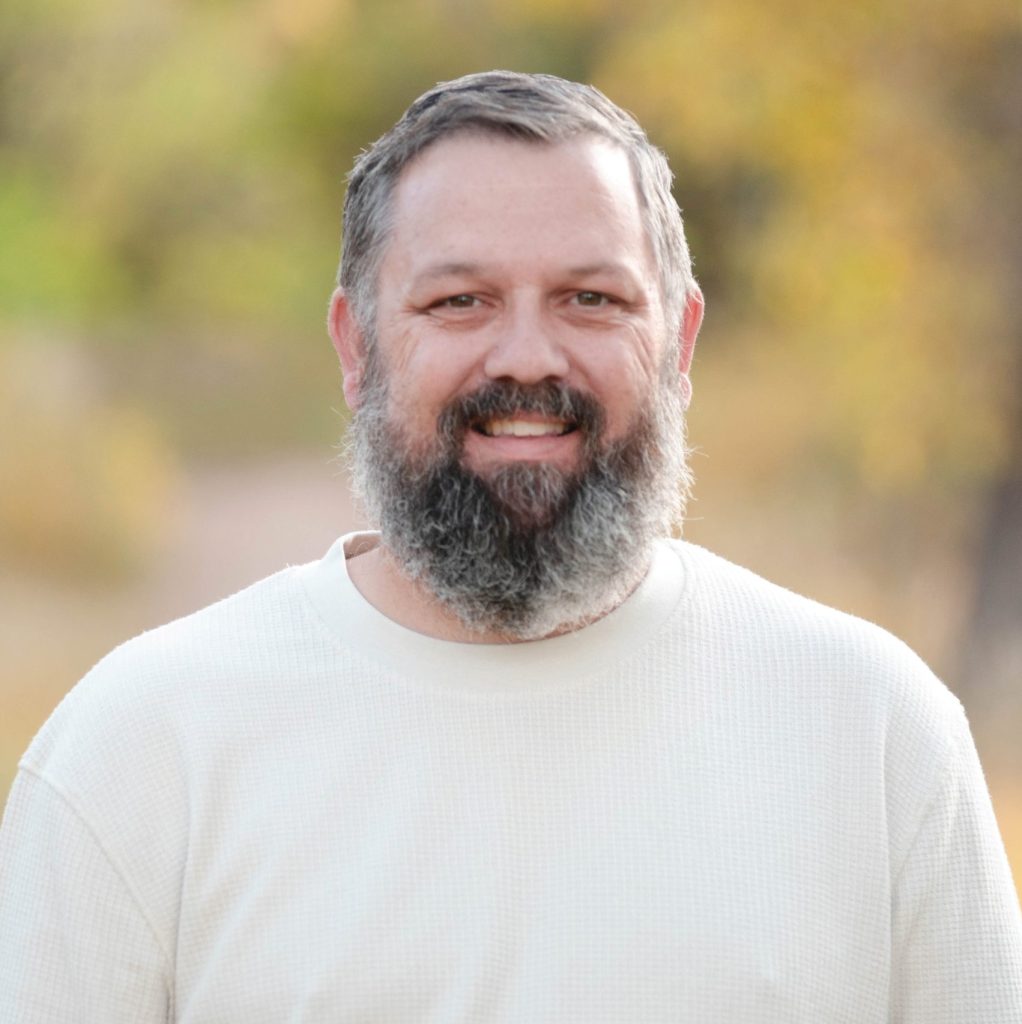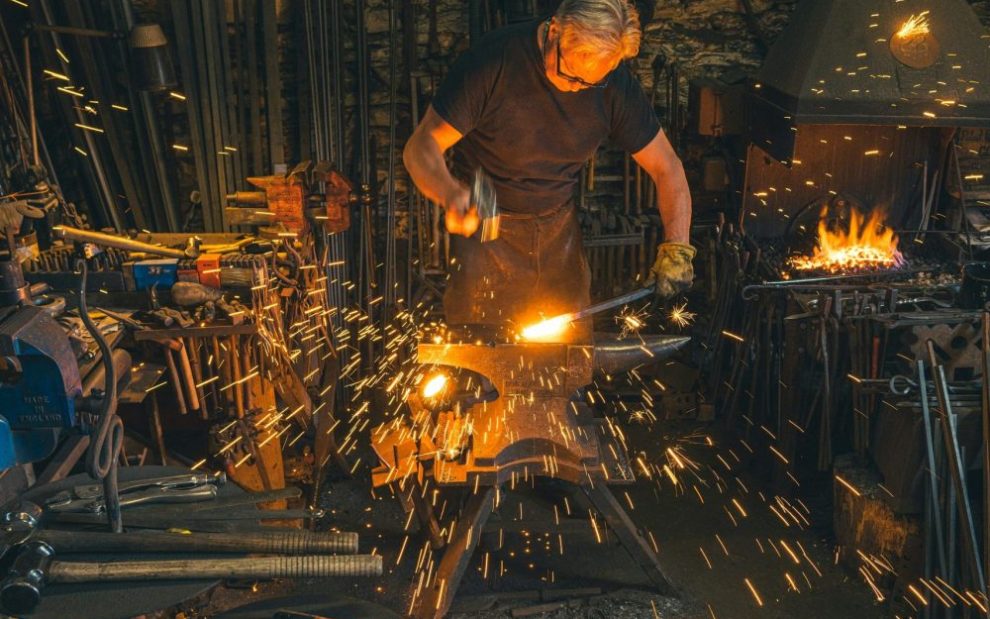
“They shall beat their swords into plowshares and their spears into pruning hooks; nation shall not lift up sword against nation; neither shall they learn war any more.” This message from Isaiah 2:4 (and Micah 4:4) appears on the website of RAWtools, an organization that seeks to end violence by turning swords into plowshares—or, in this case, literally turning guns into garden tools. Their mission, grounded in scripture, is to “disarm hearts, cultivate peace, and forge justice.”
Mike Martin, the founder and executive director of RAWtools, started the organization with his father in 2012, shortly after a shooter killed 26 people—including 20 children between the ages of 6 and 7—at an elementary school in Newtown, Connecticut. Martin and his father learned how to forge metal and began cutting up donated guns.
“Our focus is on exchanging tools of violence for tools that cultivate life,” says Martin, who is Mennonite and a former youth pastor. “Our faith calls us to be in the world in a different way.”
Today, RAWtools offers public events that range from nonviolence training to gun buyback programs. Many of these events feature live blacksmithing demonstrations where those who have been affected by gun violence are invited to pick up the hammer and help create a tool. Martin says that he feels God’s presence in these moments of shared mourning and constructive destruction. “It’s become a really powerful part of what we do,” he says.
Talk a little about the work RAWtools does.
The mission of RAWtools is to disarm hearts, forge peace, and cultivate justice. These three focuses are based in scripture: Isaiah and Micah both talk about turning swords into plowshares and studying war no more. Micah’s version goes on a little bit further and says that everyone “shall all sit under their own vines and their own fig trees, and no one shall make them afraid” (4:4).
Our mission statement connects to our work turning guns into garden tools, but it goes further than that: We also try to give people more intangible tools through mediation, de-escalation, nonviolence, and other trainings. We partner with other organizations to engage in transformative justice—restorative justice, dialogue circles, and things like that.
Then there’s this idea of cultivating justice or, to quote Micah, making sure “no one shall make them afraid.” This requires not only personal work, but also systemic change that allows us to be a little more at ease with our surroundings and in a space where fear doesn’t dictate our decisions. This work might involve resource mapping or auditing communities to see why one area has a high rate of violence and another doesn’t, for example. All this work stems from the idea of transforming swords into plowshares within a modern context.
February 11, 2024 was our 11th anniversary: We were founded two months after the Sandy Hook Elementary School shooting. A lot of organizations that address gun violence in various ways started during that time; we focus more on trauma-informed and survivor-centered work with individuals rather than legislative priorities like many of the other organizations. Our focus is on exchanging tools of violence for tools that cultivate life.
Where did the name RAWtools come from?
It was my wife’s idea: It’s war backwards. Our organization is about making that 180-degree transformation. We offer a stark contrast to how the world operates, because our faith calls us to be in the world in a different way.
Over time, the name has also come to speak to the vulnerability—the rawness—that comes with making the decision to be in the world in this new way. There’s a vulnerability in choosing nonviolence that requires a solidarity with those harmed. That’s hard to walk into sometimes.
What does that solidarity look like in your work?
A lot of people in the United States who are opponents of nonviolence will also use a lot of what if language to talk about the rationale behind peace. “What if the worst possible thing you can imagine was happening to the person you love? Would you use violence to save them?” There’s this attempt to rationalize what level of force people are OK with.
But to talk about violence and nonviolence this way is a very privileged take. And, globally, the United States in general is a privileged space when it comes to promoting nonviolence. For example, I am a white, cis, heterosexual, Christian man in America. It’s pretty easy for me to take myself out of a conversation about violence when it gets uncomfortable. In theory, nonviolence is wonderful, but in practice it requires a lot of vulnerability and solidarity with those who are most affected by violence.
Where do the guns come from that you turn into tools?
There are three ways we get our firearms. First, by individual donation through our website: People fill out a form to donate their firearm. If they donate just one, they can remain anonymous, but making multiple donations requires their information. They then get a free garden tool made out of that firearm as a thank you if they want.
We’ve also worked with confiscated firearms from law enforcement. These are usually from smaller municipalities that might confiscate a few dozen firearms over a couple years, and we’ll come by every now and then to cut them up. And finally, more recently we’ve been holding public events, like a buyback, where we offer gift cards in exchange for anonymous donation of firearms.
Do guns get turned into tools immediately?
Every time a gun is donated, no matter the path it takes to get to us, it has to be destroyed in the presence of the person donating it so that there is no legal transfer of the firearm. So we always destroy it in front of the person. For example, at these public events, it works like a drive-through. We remove the firearm from the person’s car, check to make sure it’s unloaded, and then it’s destroyed while they wait nearby in their car. Once it’s cut into pieces, then they can leave. We do that to uphold legal requirements.
What does the process of turning a gun into a garden tool look like?
So much of this process translates really well into other transformative work, such as conflict resolution. I, along with my dad and others, learned how to blacksmith so we could do this. My dad had welded before and had some metal experience, but forging and welding are two totally different things.
The forge we use is essentially a mobile farrier setup: It’s meant for someone who goes farm to farm shoeing horses. It uses the same propane tank that you use to fire up your barbecue grill, and the forge itself is smaller than that tank and set on a table. It gets up to 2,400 degrees Fahrenheit and heats up metal into a malleable state where it’s hot enough that it’s not melting but can be reshaped and reformed. The whole thing is much more accessible than I would have ever thought. And it’s a relatively small investment.
We take the metal gun barrel and cut it into five-inch sections. It takes about an hour to make each section into a mattock you can use in your garden. It requires flattening out one side of the piece of metal, which is a really basic blacksmith skill, and then splitting a fork into the other side, which is kind of a next step in learning. This also makes this tool a really great introduction to blacksmithing techniques at our public events.
What happens to the tools you make?
An individual can have a tool made from their firearm if they want. If we’re doing a public event, we often donate the tools to a local community garden or to a survivor of gun violence who spoke at the event. We also sell them on our website at rawtools.org. We put out batches of maybe 20 to 60 at a time, about four to five times a year. All our tools are made by volunteers, and so how many tools we have available depends on the time they have available.
How many guns have you turned into tools over the past 11 years?
Several thousand. We didn’t do a very good job of tracking that during our first five years, and we weren’t nearly as active, since we were figuring out gun laws and learning the best tools with which to do this work.
But over the past two years we have destroyed more than 2,000 firearms. Every year over the past eight to nine years we’ve almost doubled. Until this year; we were moving really fast, and we’ve taken a step back to make sure that we’re keeping this a healthy process instead of just cutting up as many guns as we can for the sake of cutting up guns. We want to make sure that we keep survivors at the center of what we do.
Why is melting down guns such a central part of your restorative justice work, especially with survivors of gun violence?
When I first had the idea to turn guns into garden tools, I realized that we couldn’t just ask people to give up their firearms without offering any other resources for them to feel safe or gain the skills to deal with conflict. So we want our swords to plowshares work to be a comprehensive way to address all the issues and intersections from which gun violence stems.
Gun violence stems from all these different places, and each needs a different solution. In most places across the country, about two thirds of gun deaths are due to suicide, followed by domestic violence, police violence, accidental shootings, unsafe storage of firearms, and theft. Each of these things requires its own solutions, as does the rest of the context—whether the community is rural or urban, etc.
It’s easy to get stuck in the black and white, to say, “it’s a gun problem” or “it’s a sin and violence problem.” It’s both. America is unique: Violence occurs in many places across the world, but gun violence is unique to our country. So there is no one solution: restorative justice, bystander intervention, mental health, first aid—all these skills matter in dealing with the problem. The solution must include both making guns harder to access and teaching de-escalation skills.
Sometimes it feels like a chicken or egg question: Why not just destroy guns or just offer restorative justice resources? But we want them to connect. We’ve found that doing so takes us out of our siloes and allows us to be more interconnected in the resources we offer and the approaches we take to things. For example, when we hold an event, we might have people tabling who do suicide prevention, domestic violence awareness, and even environmental justice (connecting to the garden tools side of this). None of those people have ever worked together until they meet one another at our event, but our work brings them together.
A New York Times profile described you and your work as “forging a new kind of public ritual for processing grief.” Can you talk about the role of public ritual and lament in the work you do?
During one of our first events, we invited three mothers who had lost kids to gun violence to share their experiences—one identified as Jewish, one as Christian, and one as Muslim. Afterward, when we were making a tool, it made sense to invite them to pick up the hammer themselves.
There’s this kind of sacred moment that happens when someone, especially someone who’s been impacted by gun violence, is able to physiologically release their pain, anger, and grief—all these things that we carry after trauma—into the object that hurt them, even if it’s a surrogate object. And it’s not just hurting or beating on something for the sake of beating it; it’s transforming it into something else. So this has become a really valuable ritual that we’ve made available to survivors and loved ones alike.
For members of the community, when you see someone who just shared their story pick up a hammer and beat on the thing that caused them so much pain, it’s kind of a call in to say, “This may have happened 20 years ago, but it is just as painful and just as important for us to take action as if it had happened yesterday.”
It is really one of those moments where you’re a part of something that you can’t fully describe. But it’s needed—for that person, for that community, and for each individual who witnesses it. It’s become a really powerful part of what we do.
One of the most felt things in that moment is God’s presence. When we try to explain why something horrible happened, we like to offer a lot of the blame to God. But in the space of our events, you just feel that God is with you, with the person who’s suffered so much, and with the community who is witnessing the suffering. It’s just so healing to understand that God is with us in that moment.
This article also appears in the June 2024 issue of U.S. Catholic (Vol. 89, No. 6, pages 26-29). Click here to subscribe to the magazine.
Image: Unsplash/Jonny Gios













Add comment